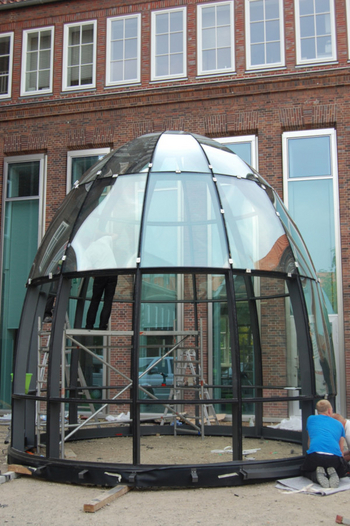
Neue Gedankenräume erobern.
“From the small Exer to the House of Science - the place, the house, its history”
Since September 2016, there has been a permanent exhibition in the south staircase of the Haus der Wissenschaft, which provides a detailed insight into the eventful history of this building. A catalog of the exhibition can be purchased at the Central Office for Continuing Education for €6. We highly recommend a visit to this permanent exhibition (open to the public free of charge from Monday to Saturday, 8 a.m. to 10 p.m.), but here are a few key facts to give you an overview:
The planning and construction of the building took place in the 1930s. Architecturally, the appearance is based on the North German brick Gothic style. During the planning phase, a new purpose was defined as an independent teacher training college (1937), which was continued as a teacher training college from 1942. The entire complex consisted of six buildings. Three low building sections with an inner courtyard for institute and administrative use, a building for the Natural History Museum, a gymnasium and the tower building as a lecture hall with an observatory. The building was inaugurated on May 23, 1937 as the “Bernhard Rust University”. Bernhard Rust was the then Reich and Prussian Minister of Science, Education and National Education. The new building was considered an example of late Expressionist architecture of the Nazi era in the sense of official state architecture.

Use of the building after the Second World War
The complex was hardly destroyed during the Second World War, so that lectures could be resumed here as early as November 1945 and opened as a university for teacher training with the name “Kant-Hochschule”.
Since 1978, teacher training and thus the preserved building complex have been part of the Technical University of Braunschweig. The use for the Natural History Museum has been retained to this day. The “Kant-Hochschule” was the first place to offer free university education after the Second World War.
At the same time, the building complex formed the actual cultural center of Braunschweig after the National Socialist oppression. Not only did the first democratic state parliament meet here, but the final session of the Braunschweig state parliament also took place in the assembly hall on November 21, 1946, when the state of Braunschweig finally became part of the new federal state of Lower Saxony.
In 1978, the state of Lower Saxony dissolved its teacher training colleges (PH). The Braunschweig PH was integrated into the Technical University. Since then, the building has been part of the TU. It houses institutes and lecture halls and, since 2009, the Student Service Center and the Haus der Wissenschaft Braunschweig GmbH. The auditorium in the tower building is a central location of the university for festive occasions and large public events.
In 2008 and 2009, the building was extensively renovated and converted with the support of the state of Lower Saxony, the TU Braunschweig and sponsors from the region (Öffentliche Versicherung, Salzgitter AG, Veolia Environnement, Stiftung Braunschweigischer Kulturbesitz). New conference rooms were created on the fifth floor. Since 2011, a glass dome, designed by O.M. Architekten and illuminated at night, has crowned the Haus der Wissenschaft.
(Based on a text by Prof. Dr. h.c. Gerd Biegel, Institute for Regional History of Braunschweig, Technical University of Braunschweig)